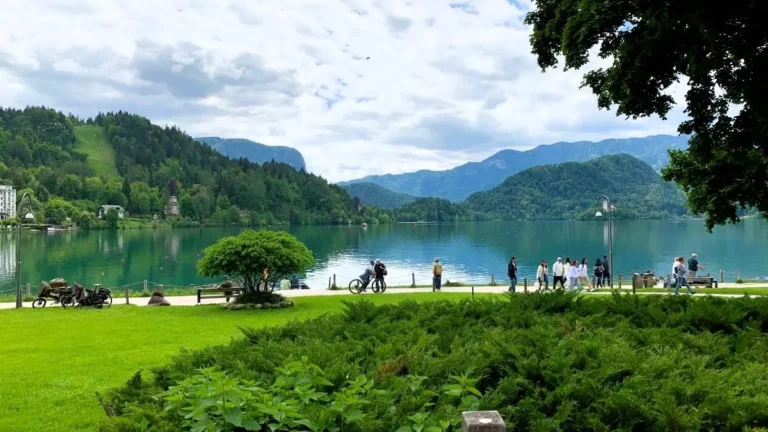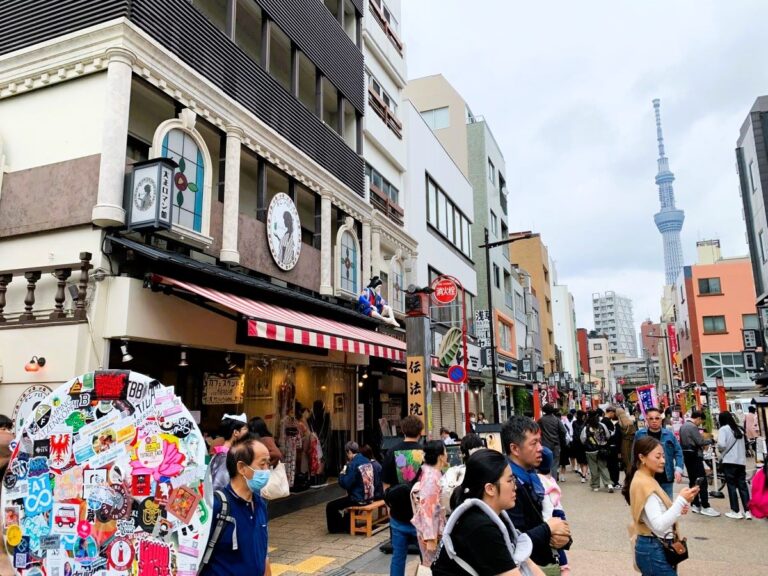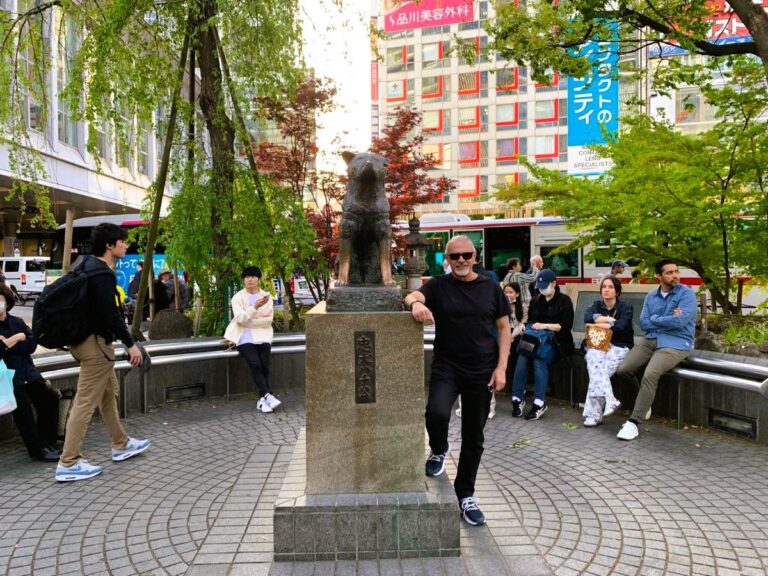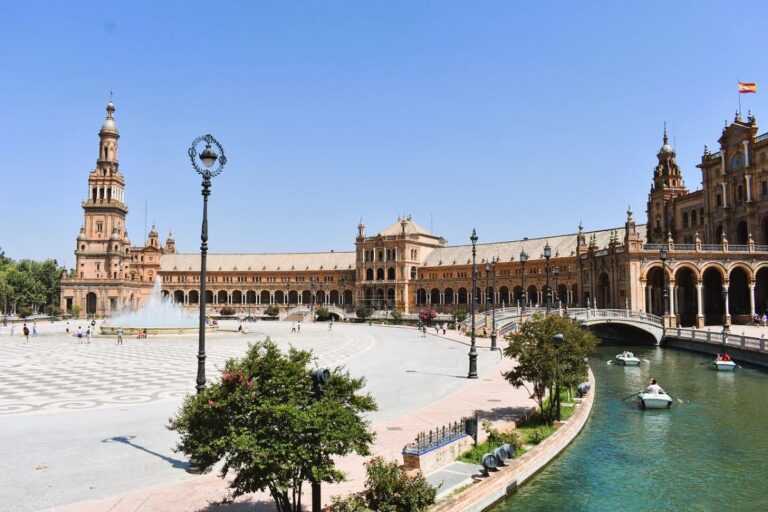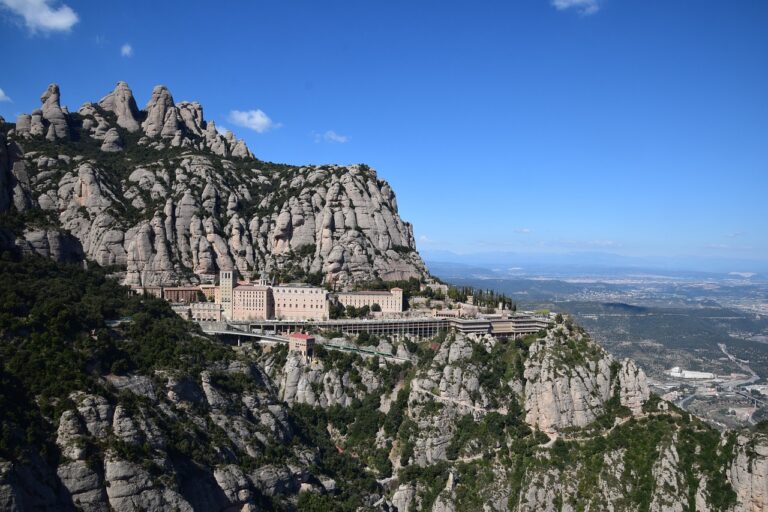Bosnia & Herzegovina Travel Guide [2025]: History, Highlights, and Essential Tips for Tourists
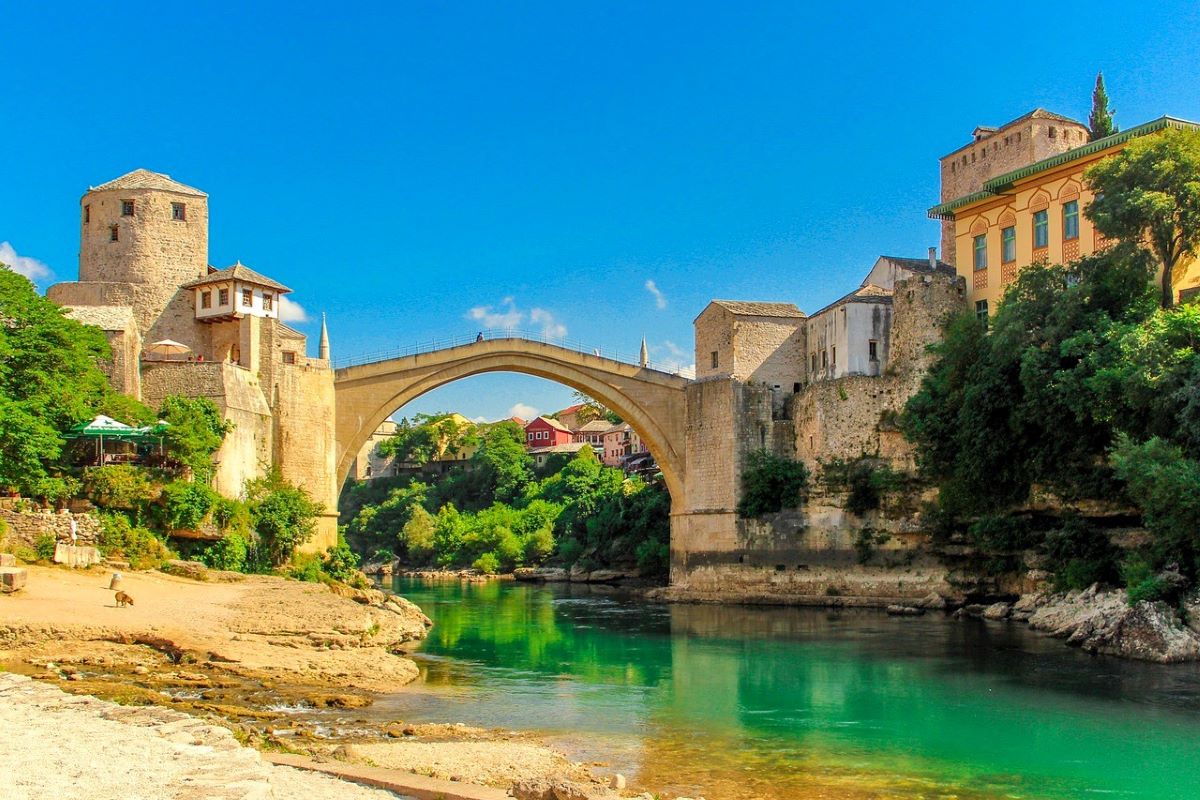
Bosnia Herzegovina stands at a true crossroads of culture and history, where Ottoman minarets share skylines with Austro-Hungarian facades and medieval fortresses.
For modern tourists, the country offers a remarkable blend of East and West—seen in the winding lanes of Sarajevo and the world-famous stone bridge of Mostar.
This Bosnia Herzegovina Travel Guide brings together the region’s complex past and vibrant traditions, along with its rivers, mountains, and untouched landscapes. Here, you’ll find practical insights into customs, key sites, safety, and how to make the most of your journey through this unique European destination.
Bosnia Herzegovina At a Glance
Bosnia and Herzegovina is a beautiful and culturally rich country in the Balkans, known for its mix of East and West, stunning landscapes, and deep history.
- Main Religion: Islam is the largest religion, followed by Serbian Orthodoxy and Roman Catholicism.
- Language: The official languages are Bosnian, Croatian, and Serbian.
- Currency: The currency is the Bosnia and Herzegovina Convertible Mark (BAM).
- Food: Traditional cuisine includes dishes like ćevapi (grilled meat rolls), burek (meat or cheese-filled pastry), and sarma (cabbage rolls). Turkish-style coffee is a cultural staple.
- Culture: Bosnia and Herzegovina has a diverse heritage with Ottoman, Austro-Hungarian, and Yugoslav influences. Its music, architecture, and traditions reflect a blend of these cultures.
- Places to Visit:
- Sarajevo – the capital, known for its multicultural charm and historic Old Town.
- Mostar – famous for the iconic Stari Most (Old Bridge) and Ottoman-era architecture.
- Blagaj – home to a stunning Dervish monastery beside a cliff and river spring.
- Jajce – known for its beautiful waterfall in the town center.
- Kravice Waterfalls – a natural paradise ideal for swimming and picnics.
A Brief History of Bosnia Herzegovina: From Ottoman Rule to the Tito Era and Beyond
Bosnia & Herzegovina’s history reaches into several centuries, marked by different rulers and changing borders. The country’s cultural layers reflect a mix of Ottoman, Austro-Hungarian, and Yugoslav influences you will notice as you travel. Understanding this background adds depth to the journey described in this Bosnia & Herzegovina Travel Guide.
Ottoman Rule and Cultural Change
From 1463 to the late 19th century, Bosnia formed part of the Ottoman Empire, which reshaped local society and daily life. The Ottomans introduced Islam to the region, building mosques, bazaars, and bridges that still define the country’s towns today. Ottoman rule fostered a society of different faiths—Muslims, Orthodox Christians, Catholics, and Jews—living close together, often within the same neighborhoods. Some iconic sights from this period, such as Sarajevo’s Baščaršija and Mostar’s Stari Most, stand as reminders of this era.
For more on how the Ottomans influenced Bosnia’s cities and religious life, see the detailed historical overview by Britannica.
Austro-Hungarian Transition
Following the 1878 Congress of Berlin, Austria-Hungary occupied Bosnia and later annexed it in 1908. The change brought European-style architecture, modern roads, and railways that reshaped Sarajevo and other towns. Austro-Hungarian rule also fostered a sense of national identity among local Serb, Croat, and Bosniak communities. Architecturally, visitors spot this legacy in the grand facades, Catholic churches, and government buildings sprinkled throughout Sarajevo and Mostar.
Kingdom, War, and Socialist Yugoslavia
After World War I, Bosnia & Herzegovina became part of the Kingdom of Serbs, Croats, and Slovenes, later known as Yugoslavia. The interwar years saw economic shifts and rising tensions among communities. World War II was a difficult period marked by occupation and violence that still shapes families and memories today.
With the war’s end, Bosnia joined the Socialist Federal Republic of Yugoslavia under Josip Broz Tito. The Tito era, from 1945 to 1980, brought industrialization, new factories, and large-scale rebuilding. Cities across Bosnia saw new construction as Tito’s policy encouraged the union of Yugoslavia’s many ethnic groups.
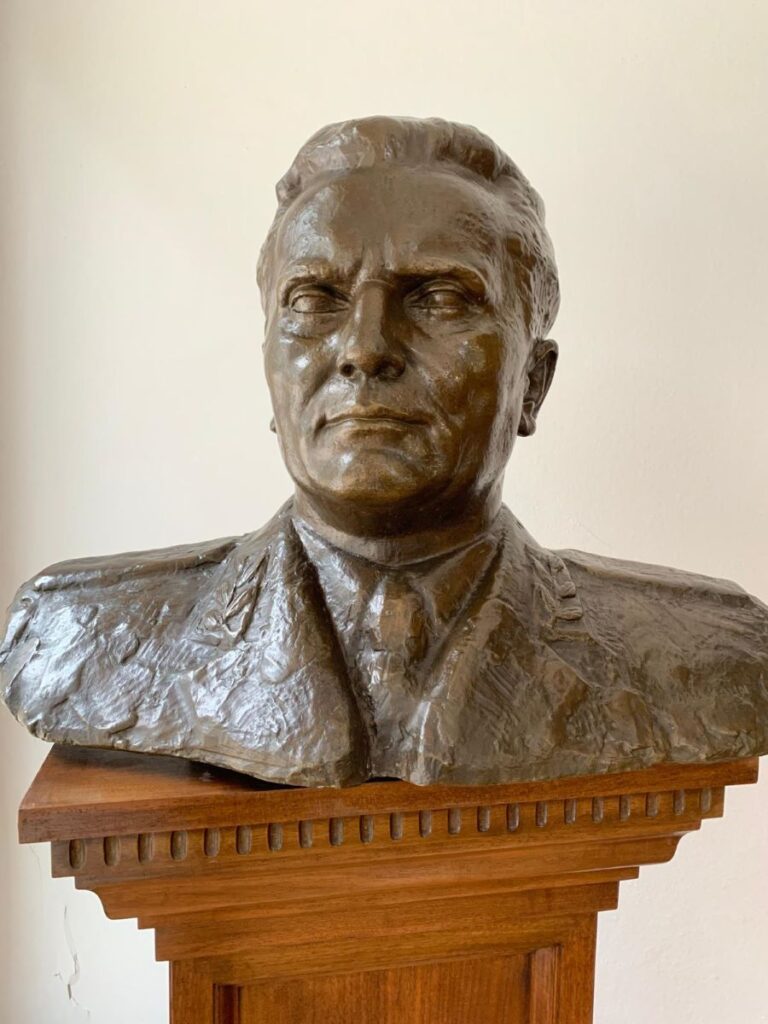
This time also produced a sense of “Brotherhood and Unity,” though ethnic identities and local traditions continued to matter in daily life.
Discover a full timeline and more context with History of Bosnia and Herzegovina.
Beyond Tito: The 1990s and Modern Times
Tito’s death in 1980 left Yugoslavia with economic troubles and rising nationalism. In the early 1990s, Bosnia & Herzegovina declared independence, a move recognized internationally but quickly followed by armed conflict. The Bosnian War dramatically affected the country, reshaping borders and leaving lasting scars.
Today, Bosnia & Herzegovina is an independent nation, drawing from its blended past to create a unique identity. Many sites throughout Sarajevo, Mostar, and the countryside bear quiet witness to both hardship and resilience—a key theme throughout any meaningful Bosnia & Herzegovina Travel Guide. For more details about transitions since the Tito era, visit The History of Bosnia & Herzegovina.
Top Destinations: Sarajevo, Mostar, and Hidden Gems
Bosnia & Herzegovina presents visitors with a collection of cities and landscapes shaped by centuries of migration, trade, and cultural exchange. From the vibrant streets of Sarajevo to the timeless arches of Mostar’s stone bridge, every site has its own story. Below, this Bosnia & Herzegovina Travel Guide highlights must-see destinations and uncovers natural wonders for those seeking something beyond the well-known paths.
Sarajevo: The Heart of Bosnia
Sarajevo’s setting in a narrow valley, surrounded by thick forests and distant peaks, gives it a sense of both openness and intimacy. The city is famous for its mix of mosques, synagogues, churches, and remnants of Ottoman and Austro-Hungarian rule, all clustered within short walking distance. Stand in Baščaršija, the Ottoman-era bazaar, and you’ll move through a living history where trade and faith once connected East and West.

Notable features include:
- Gazi Husrev-beg Mosque: The centerpiece of Sarajevo’s Islamic heritage, with its elegant minaret and shaded courtyards.
- Sacred Heart Cathedral: Offering a glimpse of Catholic tradition amid narrow streets.
- Old Orthodox Church: Soaked in centuries-old tradition, representing the city’s Orthodox Christian history.
- Latin Bridge: Famous as the site of Archduke Franz Ferdinand’s assassination in 1914.
The city’s cultural layers show in everyday life, from bakeries selling both baklava and Austrian-style sweets to locals speaking a blend of Slavic and Turkish words. Sarajevo remains a symbol of unity and diversity throughout the Balkans.
Mostar and the Iconic Stari Most
Mostar draws visitors from across Europe with its iconic bridge, Stari Most, arching over the Neretva River. Built in the 16th century during Ottoman rule, the bridge became an architectural marvel and a symbol of the city’s endurance. The original structure was destroyed during the conflict in the 1990s but rebuilt to its old beauty in 2004 using traditional methods.
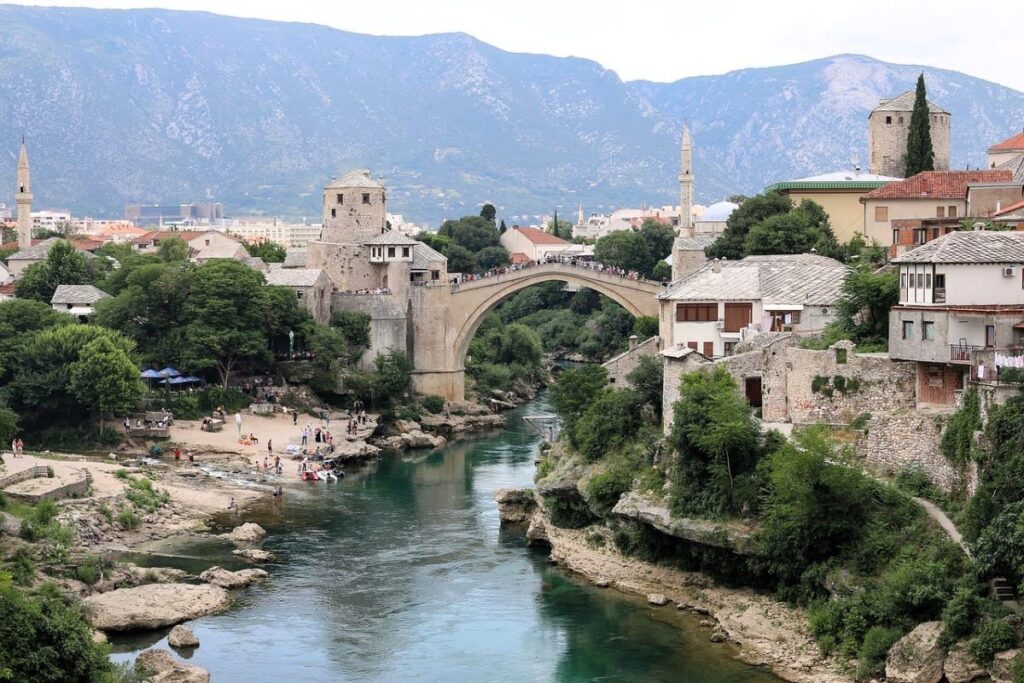
The old town around Stari Most remains the centerpiece of Mostar’s charm:
- Stari Most (Old Bridge): Connects the two halves of the city and is still used by local divers who leap into the cold river below.
- Ottoman-era houses: Many have been restored, lining cobblestone streets with their whitewashed walls and wooden balconies.
- Koski Mehmed-Pasha Mosque: Offers panoramic city views from its slender minaret.
- Traditional bazaar: Sells copperware, carpets, and sweets, offering a sense of daily life that stretches back centuries.
Mostar’s mix of resilience, architectural beauty, and cultural significance makes it a standout stop in any Bosnia & Herzegovina Travel Guide. For more insight into the city’s story and its enduring legacy, refer to the Lonely Planet guide to Bosnia & Herzegovina.
Blagaj: A Hidden Gem at the Source of the Buna River
Tucked away just a short drive from the bustling streets of Mostar lies Blagaj, one of Bosnia and Herzegovina’s most enchanting and serene destinations.
With its postcard-perfect scenery, spiritual heritage, and riverside charm, Blagaj feels like a place suspended in time—where nature and history flow together as effortlessly as the crystal-clear Buna River emerging from a cavern beneath a towering cliff.
What makes Blagaj truly special is the Blagaj Tekija (Dervish Monastery), a stunning 16th-century Sufi monastery built right into the base of a dramatic karst cliff. Set beside the powerful source of the Buna River, the Tekija is one of the most photographed and spiritually significant places in the country.
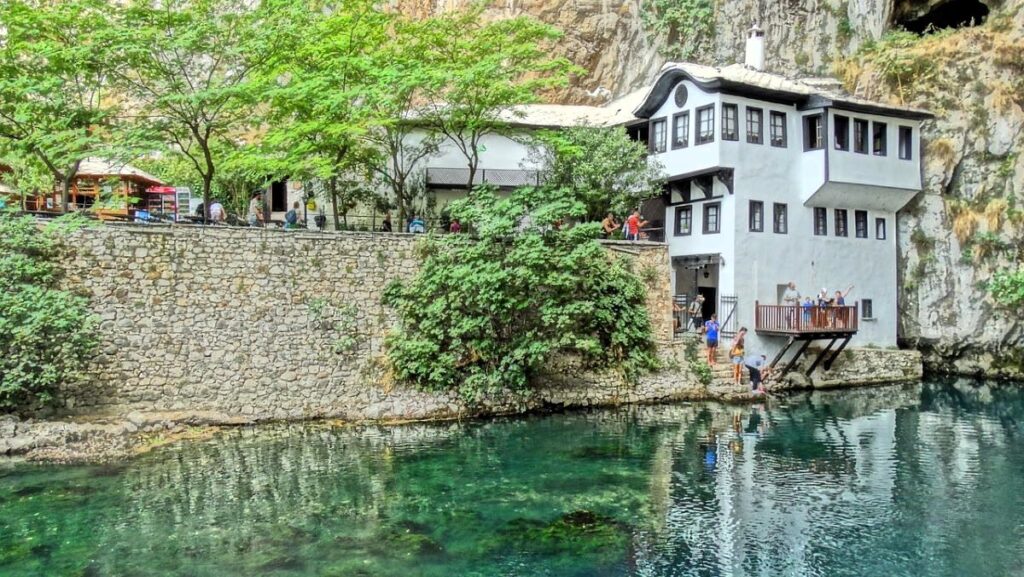
The sight of white Ottoman-era architecture hugging the rock face, with the emerald waters of the Buna gushing forth beside it, is simply unforgettable.
But Blagaj is more than just a scenic photo stop—it invites you to slow down and soak in its peaceful atmosphere. You can visit the monastery, which is still active, and step inside to learn about the mysticism of the dervishes, their rituals, and their deep connection with nature. A short walk along the river offers multiple viewpoints and quiet spots for reflection.
Don’t miss the chance to enjoy lunch at one of the riverside restaurants, where you can savor fresh trout while listening to the soothing rush of the Buna. Adventurous visitors can even take a boat ride into the cave from which the river springs, getting an up-close look at this natural marvel.
Whether you’re a nature lover, a history buff, or simply looking to escape into a peaceful setting, Blagaj offers a tranquil retreat and a glimpse into Bosnia’s rich spiritual traditions. It’s the kind of place that stays with you long after you’ve left—calm, mysterious, and quietly awe-inspiring.
Natural Attractions: Waterfalls, National Parks, and Outdoor Adventures
Nature is a key part of the country’s identity, offering dramatic scenery and a range of outdoor activities that remain underappreciated on the European travel circuit. Whether you enjoy hiking, rafting, or simply seeking a quiet spot, Bosnia & Herzegovina provides many options.
Popular nature destinations include:
- Kravice Waterfalls: Located near the town of Ljubuški, these wide cascades spill into a natural pool, inviting visitors for summer swimming and picnics.
- The Dinaric Alps: These rugged mountains offer hiking trails, climbing routes, and winter sports near towns like Konjic and Jablanica.
- Una National Park: The Una River, with its emerald-green waters and lively rapids, provides a perfect setting for rafting, kayaking, and fishing.
- Blidinje Nature Park: Home to glacial lakes, dense forests, and rare wildlife.
Outdoor activities appeal to travelers seeking both relaxation and adventure. In spring and summer, the rivers and lakes become hubs for canoeing and fishing, while autumn brings a burst of color across the forested hills. Those with a love of hiking can cross paths with shepherds and spot scattered stećci, the region’s medieval tombstones, along rural trails.
This harmony between nature, culture, and community gives Bosnia & Herzegovina a distinct character, touching every aspect of the trip. For further recommendations on outdoor sites and activities, explore Rick Steves’ Bosnia-Herzegovina highlights.
Culture and Customs: Traditions, Food, and Practical Etiquette
Bosnia Herzegovina offers visitors a rich cultural experience that springs from centuries of intersecting influences. Local customs and daily habits echo Ottoman, Central European, and Balkan roots, giving the country its special warmth and openness.
Understanding daily etiquette, traditional foods, and long-standing customs brings travelers closer to the heart of local life. This part of the Bosnia Herzegovina Travel Guide explores the rituals, meals, and manners that shape daily experience across villages and cities.
Traditions and Hospitality
Customs in Bosnia & Herzegovina build a strong sense of hospitality and respect, traits valued by locals across generations.
- Hospitality plays a central role. Guests are seen as blessings, and hosts go out of their way to welcome you. You may be offered coffee or sweets even during a brief visit.
- Respect for elders is consistent. When you meet a family or visit a home, greetings start with older members. Locals use more formal language and polite titles for elders, reflecting long-standing respect within families and communities.
- Mix of customs from Islamic, Christian, and Jewish traditions continue to shape life together, especially in shared festivals and holidays.
- Life celebrations like weddings, births, and religious festivals involve generous meals and music, often stretching well into the night. It’s common for entire neighborhoods to join in.
For further detail on social life and customs, Bosnian Culture | Customs | Traditions | Etiquette gives helpful examples of how hospitality shapes everyday encounters.
Traditional Food and Cuisine
Bosnia & Herzegovina’s cuisine blends Turkish, Mediterranean, and Eastern European influences. Meals carry meaning beyond simple nourishment, often representing family unity and a sense of belonging.
- Typical dishes include:
- Ćevapi: Small, grilled minced meat sausages served with flatbread and raw onions.
- Burek: A flaky pastry filled with minced meat, cheese, potatoes, or spinach.
- Begova čorba: A slow-cooked chicken and vegetable soup featuring okra, resembling dishes found in Turkish kitchens.
- Baklava: A sweet pastry made with nuts and syrup, commonly served with coffee after meals.
- Dining customs highlight shared plates and generous portions. Meals usually begin with soup and bread, followed by grilled meats, vegetables, and salads.
- Coffee culture is strong, echoing Ottoman influence. Thick Bosnian coffee, prepared in a small copper pot called a džezva, forms the centerpiece of social gatherings. It’s typically served with a sugar cube and a few Turkish delights or rahatlokum.
To learn more about Bosnian specialties and dining habits, visit the comprehensive overview at Bosnia and Herzegovina cuisine.
Practical Etiquette: Social Norms and Everyday Manners
In day-to-day life, small gestures and polite standards shape how people interact, especially when meeting someone new or visiting local homes.
- Greetings: A firm handshake and direct eye contact are standard, though closer friends may also exchange kisses on the cheek. Always greet older people first as a sign of respect.
- Dress: Urban centers tend toward casual, modest clothing, but in smaller towns and rural areas, dressing neatly is appreciated, especially around religious sites or family gatherings.
- Shoes: Remove your shoes before entering someone’s home. Hosts will often provide slippers for guests, following a custom common across the Balkans.
- Gift giving: When visiting a local family, it’s polite to bring a small gift—a box of chocolates, coffee, or even flowers shows appreciation.
- Conversation: Topics like family, sports, and local history are welcome. Most people avoid political debates, especially with new acquaintances.
For more guidance about daily etiquette and key expectations, the Bosnian culture etiquette guide delivers useful tips for both tourists and business travelers.
Understanding these core traditions and everyday habits brings a deeper appreciation of life in Bosnia & Herzegovina, connecting visitors with the welcoming spirit that has endured for generations.
Travel Essentials: Currency, Visas, Health, and Safety
Every visitor should be aware of key travel essentials before visiting Bosnia & Herzegovina. Staying informed about currency use, visa policies, health precautions, and safety measures can smooth the journey and help travelers enjoy everything this historic country has to offer. This section of the Bosnia & Herzegovina Travel Guide provides practical details you will need as you plan your trip.
Currency and Payments
Bosnia & Herzegovina uses the Convertible Mark (BAM) as its official currency. Currency exchange services are available at banks, exchange offices, hotels, and airports. While some businesses in larger cities may accept euros, expect to pay in BAM at most restaurants, shops, and accommodations, particularly outside tourist centers.
- ATMs are widespread in major towns and cities, but cash remains the preferred payment method, especially in rural areas.
- Credit cards are accepted in hotels, larger stores, and some restaurants, but many smaller venues operate on a cash-only basis.
- Keep some coins and small bills handy for public transport, markets, and tipping.
The current exchange rate remains stable, but check updated rates with your bank or a reliable source before your trip. Bringing a backup credit or debit card is recommended, as card acceptance varies away from main tourist hubs.
Visas and Entry Requirements
Entry into Bosnia & Herzegovina is relatively straightforward for most travelers. Citizens from the European Union, the UK, the United States, Canada, Australia, and many other countries do not require a visa for stays up to 90 days within a six-month period. A valid passport is required, with at least three months’ validity beyond your planned departure date.
- If you plan to stay longer than three days, you must register your presence with the local police or through your hotel within 48 hours of arrival.
- For minors traveling alone or with one parent, notarized parental consent may be required.
- Travelers with dual nationality should be mindful of potential legal distinctions when entering or departing the country.
More details on entry requirements and the latest updates can be found at the Bosnia and Herzegovina International Travel Information.
Health Advice and Medical Services
While traveling in Bosnia & Herzegovina, it is important to pay attention to both routine and location-specific health guidelines.
- Ensure your routine vaccinations are up to date, including measles, mumps, rubella, hepatitis A and B, and tetanus.
- Bottled water is widely available, and tap water in Sarajevo and many towns meets international standards, but using bottled water in rural areas is safer.
- Medical care in Sarajevo is adequate for minor issues; however, facilities outside the capital are basic, so a comprehensive travel health insurance plan with medical evacuation is highly recommended.
- Pharmacies are common in urban areas but may have limited hours or reduced stock in remote locations.
The air quality can deteriorate during the winter months due to smoke and vehicle emissions. Those with respiratory sensitivities should check daily air quality indexes, especially in Sarajevo.
Read more health and safety updates at Health and Safety Considerations for Visiting Americans.
Safety Precautions and Local Laws
Bosnia & Herzegovina is welcoming to tourists, but travelers must remain aware of certain risks and local customs for a secure visit.
- Landmines remain a hazard in rural and mountainous areas, marked by yellow tape or warning signs. Always stay on paved roads and established trails.
- Petty crime such as pickpocketing and bag snatching is most common in busy towns and public transport. Keep valuables secure and avoid carrying large sums of cash.
- Political demonstrations occur from time to time, particularly in city centers. Avoid these gatherings, as situations may shift quickly.
- During winter, road conditions may deteriorate due to snow and fog. Drive cautiously and use well-maintained routes; carrying an international driving permit is recommended if renting a car.
It is required to carry your passport or official ID at all times, as police may request identification. For in-depth safety tips, consult Bosnia & Herzegovina Travel Advice & Safety and review up-to-date travel advisories.
Emergency contacts to remember:
- General emergency: 112
- Police: 122
- Ambulance: 124
- Fire services: 123
Preparation and respect for local guidance will help visitors stay safe and comfortable as they explore the history and culture detailed in this Bosnia & Herzegovina Travel Guide.
Best Time to Visit: Weather and When to Go
The climate in Bosnia & Herzegovina is shaped by its mountains, valleys, and a narrow stretch of Adriatic coast. These varied landscapes give the country diverse seasons, each offering its own appeal for travelers. The timing of your stay will influence what you see and experience, from city festivals and outdoor activities to winter sports in the highlands or summer swims along the coast. The Bosnia & Herzegovina Travel Guide highlights the ways the seasons can shape your visit.
Overview of the Seasons
Bosnia & Herzegovina has four clear seasons: spring, summer, autumn, and winter. The interior has a continental climate with hot summers and cold winters, while Herzegovina along the Adriatic sea tends toward a Mediterranean climate with mild winters and dry, hot summers.
- Spring (March–May): Days grow longer, hillsides green, and wildflowers bloom along riverbanks and meadows. Average daytime temperatures reach 10–20°C (50–68°F). Rain is more frequent, especially at higher elevations, bringing lush scenery and fast-flowing rivers ideal for adventure sports.
- Summer (June–September): Warm to hot temperatures, often between 25–35°C (77–95°F). Summers bring dry, bright weather, perfect for city sightseeing, open-air festivals, and hiking in the mountains. Herzegovina’s beaches around Neum fill up as locals and visitors seek relief from the heat.
- Autumn (September–November): Early autumn is mild, with temperatures cooling to 10–20°C (50–68°F). Hills and forests take on deep red and gold colors, creating scenic drives and good hiking weather. Rain becomes more common by late October.
- Winter (December–February): The mountains see heavy snowfall, especially from December through March. This is prime time for skiing and snowboarding around Jahorina and Bjelašnica. Valley towns turn quieter, and lower regions are chilly but rarely frigid.
See a detailed season-by-season summary at Responsible Travel’s guide to the best time to visit Bosnia-Herzegovina.
When to Go: Month-by-Month Highlights
Choosing the best time depends on what you want to experience. Here’s what each period offers:
- April to June: Trees and gardens are at their peak, with city parks and riversides full of life. Sarajevo and Mostar host cultural events, outdoor cafes reopen, and hiking trails become accessible. Spring rain feeds the waterfalls, making spots like Kravice especially dramatic. These months see fewer tourists than high summer, giving a quieter atmosphere in both cities and towns.
- July and August: The country’s warmest months, ideal for exploring rivers, lakes, and Neum’s coastline. This is festival season in Sarajevo and other large towns, with outdoor concerts and late-night gatherings. Trails at higher elevation remain cool enough for hiking, and adventure operators run rafting trips while river levels are still strong. Popular sites will be busier, especially during local holidays.
- September and October: Many consider early autumn the very best time to visit. Temperatures are pleasant, crowds thin out, and the landscape glows with autumn colors. It’s an excellent period for both city tours and rural stays. Local farmers’ markets fill with figs, apples, and grapes. Rain increases toward November, but October stays mainly dry and sunny.
- November to March: Shorter days and cold weather shift focus to winter sports. Resorts like Jahorina and Bjelašnica offer reliable snow and welcoming guesthouses. Most cities are quieter, and while the charm of Sarajevo’s historic quarters remains, some rural attractions close for the season. Winter is suited for travelers interested in skiing, snowboarding, or experiencing the country’s quieter side.
A helpful reference for comparing seasons and weather patterns is available from the Absolute Best Time to Visit Bosnia & Herzegovina.
Climate by Region: Mountains, Valleys, and Coast
Geography greatly influences the local weather, so consider where you want to spend most of your trip.
- Mountain regions: Cold and snow-heavy winters; summers stay cooler, suitable for outdoor sports.
- Central valleys: Hot summers, cold winters, and milder spring and autumn months.
- Herzegovina’s southern districts (like Mostar): Drier, with longer summers—rainfall drops off in July and August, while winters rarely bring much snow.
- Neum (the Adriatic coast): Mild winters and warm, sunny summers make Neum the country’s best beach spot.
For more details on the country’s climate, visit the Thomas Cook guide to the best time to visit Bosnia and Herzegovina.
Activities by Season
To match your interests with the best time to visit, here are common activities by season:
- Spring: Waterfall visits, hiking in parks, city sightseeing, and river rafting.
- Summer: Open-air festivals, outdoor cafes, beach trips, hiking in highlands, and visiting historic towns.
- Autumn: Countryside walks, harvest celebrations, and scenic drives through forests and valleys.
- Winter: Skiing, snowboarding, and quiet city stays with cozy cafes and winter markets.
Learn more about unique seasonal experiences with Bosnia-Herzegovina: The Best Travel Time for Unique Experiences.
Bosnia & Herzegovina welcomes visitors year-round, adapting its cities and rural attractions to every season. The key is to plan with both the climate and your interests in mind, drawing from the guidance in this Bosnia & Herzegovina Travel Guide to make the most of your journey.
Conclusion
Bosnia & Herzegovina stands apart for travelers who appreciate a deep blend of history, diverse culture, and natural beauty. In this Bosnia & Herzegovina Travel Guide, timeless towns, mountain trails, and living traditions come together in a country that bridges East and West with quiet confidence. Old bridges like Mostar’s, the winding alleys of Sarajevo, and rivers tumbling through green valleys create a journey that rewards open eyes and patience.
Each visit invites travelers to listen as much as to look, respecting the enduring stories written into mosques, churches, and everyday rituals. Simple courtesy and a willingness to learn go far in a place where hospitality remains a point of pride. For those ready to explore beyond the usual, Bosnia & Herzegovina offers new perspectives and a lasting sense of connection.
Share your impressions, travel responsibly, and let the history you find here enrich your own. Thank you for reading—may your journey bring both understanding and enjoyment.
Recent Posts:
-
Lake Bled Day Trip: The Perfect First-Time Adventure from Ljubljana
Welcome! If you’re spending time in Ljubljana and want to experience Slovenia’s most magical landscapes, a Lake Bled day trip from Ljubljana is an easy choice. With its glacial blue water, Lake Bled Island at its center, and Bled Castle perched high on the cliffs, this spot looks straight out of a fairytale—no need for…
-
Best Things to Do in Ljubljana, Slovenia (First-Time Visitor’s Guide)
Welcome! Thank you for visiting my blog about the best things to do in Ljubljana! In this guide I’ll share my own favorite spots and handy tips, best places to eat and some local insights you might not find elsewhere. Ljubljana, the charming capital of Slovenia, is stunning! The architecture is breathtaking! I promise you,…
-
Best Tango Shows in Buenos Aires: My Guide for First-Time Visitors
Buenos Aires is the birthplace of tango – raw, passionate, and unforgettable! But if it’s your first time in the city, choosing the right tango show can feel overwhelming. Do you go for the glamorous, cabaret-style performance with a gourmet dinner? Or do you slip into a smaller, historic venue where tango feels more like…
-
Recoleta Cemetery in Buenos Aires: History, Highlights, and Visitor Tips for 2025
Welcome to Recoleta Cemetery! “If you’re visiting Buenos Aires, this is a place you should see at least once. You’ll leave with photos, stories, and a deeper understanding of Argentina’s history.” Related Posts: Introduction: Why Visit Recoleta Cemetery? Recoleta Cemetery in Buenos Aires is not your typical graveyard.It’s more like an open-air museum filled with…
-
Tokyo vs Osaka: Your Guide To Understanding The Difference Between The Two Most Popular Cities in Japan [2025]
So the question is, Tokyo or Osaka which is better? Do you want to pick between the two? It can feel like it’s hard to decide, especially if it’s your first trip to Japan. We’ve been to both. We loved them both. We spent more days in Osaka than we did in Tokyo, and did…
-
The Ultimate 5-Day Itinerary in Tokyo: A Fun and Easy Guide for First-Time Visitors
5 Day Itinerary in Tokyo – A City of Contrasts and Wonders I’ve created this 5 day itinerary in Tokyo to help you get the most out of your time here. It’s based on my own experience in this incredible city. Tokyo is one of the most exciting cities in the world. It’s a place…

